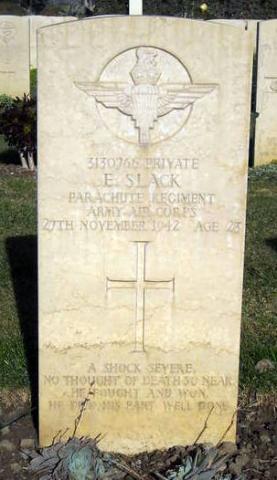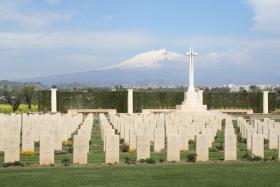Private Edward Slack was the son of Richard and Ethel Slack, of Hoyland, Yorkshire. He joined up with his brother Leslie Slack (who also later died as an Airborne soldier at Arnhem) into the Royal Scots Fusiliers on the 22 April 1939. [1]
He was serving in the 50th (Holding) Battalion, The Royal Scots Fusiliers, when he volunteered for Airborne Forces and after completing the selection process at Hardwick Hall was sent to RAF Ringway with four Officers and eighty six Other Ranks of the 1st Parachute Battalion to do Parachute Course No 8. This ran from the 10 to the 24 February 1942, and he completed the required two balloon and five aircraft descents to qualify for his ‘wings’. [1] & [2]
He was assigned to No 3 Section, under the command of Sgt DG Barrett, in No 1 Platoon, ‘R’ Company, which was commanded by Lieut T Beevers. In October 1942 he sailed to North Africa to take part in Operation ‘Torch’. On the 16 November 1942 the battalion took off from Maison Blanche Airfield in Algiers and jumped at Souk-el-Arba in Tunisia. They soon moved to the Beja area, where they remained in almost continuous action for the next few weeks.
‘R’ Company were detached from the rest of the battalion from the 19 to the 25 November, to support French troops that had joined the Allied side. On the 24 November the War Diary of the 1st Parachute Battalion had the following entry:
‘At 1000 hours at the request of Officer Commanding, 2nd Bn, The Lancashire Fusiliers a patrol of one officer (Captain Stewart) and ten Other Rank’s from the Company and a Section from 2nd Bn, The Lancashire Fusiliers moved out by Motor Transport towards Medjez covered by Carriers. This patrol contacted the enemy and none returned; Captain Stewart’s body was recovered several days later and it must be assumed that all were casualties.’
One of the ten Other Rank’s was Pte. Slack, who was taken prisoner. He was flown back to Sicily, en-route to a POW Camp. However, he died there on the 27 November 1942, aged 23 years old.
He was not officially reported as missing until the 4 December, so it would have been some considerable time before his family knew what had happened to him.
He is now buried at Catania War Cemetery, Sicily, II. D. 41.
NOTES:
[1] The Parachute Regiment, Transfer & Enlistment Book 05, page 39.
[2] Parachute Course Report, RAF Ringway. February 1942.
Profile created by R Hilton. Image supplied by Phil Jennet
Read More


Latest Comments
There are currently no comments for this content.
Add Comment
In order to add comments you must be registered with ParaData.
If you are currently a ParaData member please login.
If you are not currently a ParaData member but wish to get involved please register.